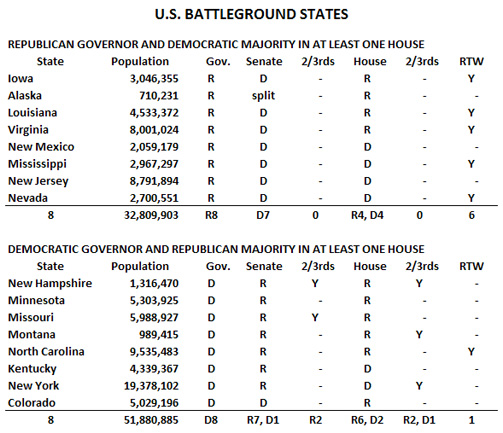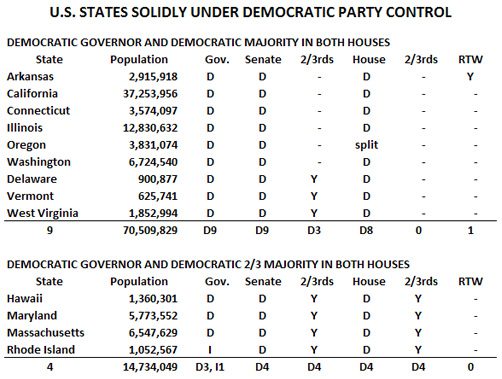State Politics & Right-to-Work
While much analysis has been forthcoming on the impact of the November 2010 election on the U.S. Senate and U.S. House of Representatives, it is harder to get compiled information on how that election affected political control of 50 states. An excellent source for this much larger body of data comes from the American Legislative Exchange Council, who just released the report Political Profiles of State Legislatures 2011, which, when compared to their report from last year, Political Profiles of State Legislatures 2010, provides dramatic evidence of the changes wrought by the November election.
A brief summary of what November 2010 did to the political landscape of the 50 state legislatures is this: Before the election the Republicans controlled both houses of 16 state legislatures (counting Nebraska, which only has a Senate), the Democrats controlled both houses of 27 state legislatures, and 7 states had one party controlling each house. After the election the Republicans controlled both houses of 26 legislatures, the Democrats controlled both houses of 15 state legislatures, and 9 states had one party controlling each house. If you simply total up the number of state legislators affiliated with the major parties, in state senates the totals changed from 1,025-897 in favor of Democrats before the election to 1,023-889 in favor of Republicans afterward, and in state houses the totals changed from 3,023-2,354 in favor of Democrats before the election to 2,916-2,466 in favor of Republicans afterward
There was an equally dramatic shift in Governor’s races, changing from 26-24 in favor of Democrats before the November election, to 29-20 in favor of Republicans afterward (Rhode Island’s Lincoln Chafee is an independent).
The three tables below put the shift in America’s political landscape into a more detailed perspective, dividing the states into three groups; Republican controlled states, Democratic controlled states, and so-called “battleground” states. The tables and sub-tables progress, somewhat subjectively, in a progression from solidly Republican to solidly Democratic.
In the above table it can be seen that in ten states, with a total population of 40 million, there are not only Republican governors and Republican control of both houses, but in both legislative houses the Republicans hold a 2/3rds majority (Nebraska’s unicameral senate has 2/3rds of the legislators self-identifying as Republicans). In another eleven states, with a total population of 98 million, there are Republican governors and Republicans control both houses, with three state senates and one state assembly having 2/3rds Republican majorities. It is interesting to note that all of the ten most solidly Republican states are right-to-work states, and five of the eleven next most solidly Republican states are right-to-work states. It is also interesting to note that at least three of these states, Texas, Florida and Arizona, with combined populations totaling over 50 million, have substantial percentages of ethnic minorities. Probably the most significant factor on this table is the presence of the big industrial states of Michigan, Ohio and Pennsylvania, totalling 34 million people, which have moved out of the battleground category – if not the solidly Democratic category – and come under the decisive control of Republican politicians.
The next table displays battleground states, where neither political party exercises clear dominance. These states are separated into two groups, the first with Republican governors, and the second with Democratic governors.
In the first group of eight states, totaling 33 million in population, four of the Republican governors have a Republican assembly and, with the exception of Alaska whose senate is split equally, a Democratic state senate. In the other four, the Republican governors confront a state legislature where both houses are Democratic. Five of these states are right-to-work states. The second group of eight states, totaling 52 million in population, have Democratic governors – with five of those governors confronting state legislatures where both houses are Republican. Only one of these states is a right-to-work state. Probably the most interesting battle ahead is New York, where a Republican senate faces off against an overwhelmingly Democratic assembly, with a Democratic governor whose positions on some issues are becoming, if not nonpartisan, emblematic of a schism developing between Democrats who are controlled by public sector unions who simply want to raise taxes, and those who are realistically trying to confront fiscal realities – and save their party – through reinventing social programs and reducing public employee compensation packages.
The next table shows those states remaining solidly under Democratic party control. Leading the list are the colossal states of California and Illinois, with a combined population of over 50 million people, and a colossal set of financial challenges.
If one compares the total population of states that have Democratic governors and 2/3rd majorities in both state houses, 15 million, with the total population of states that have Republican governors and 2/3rd majorities in both state houses, 40 million – and the total population of states that have Democratic governors and simple majorities in both state houses, 70 million, with the total population of states that have Republican governors and simple majorities in both state houses, nearly 100 million – the true size of the Republican victory last November can be readily apprehended – as well as what this portends for 2012.
Another interesting correlation – because it is nearly absolute, is the presence or absence of right-to-work laws in states that are either solidly Republican, 10 for 10, or solidly Democratic, 0 for 4. As one picks their way through the states in between these extremes the correlation continues to apply – the more Republican a state is, the more likely it is to be one of the 22 states who have right-to-work laws. A good source of information on right-to-work can be found on the Labor Union Report website in an article entitled “Advancing the Right to Work.” And if one wonders whether or not the presence of right-to-work laws is the cause or the effect of Republican political control in various states, it is helpful to consider precisely what these laws mean. Here is the definition of right-to-work, in summary:
A “Right-to-Work” state forbids workers from being fired for non-payment of union dues or fees.
A “Non-Right-to-Work” (or forced unionism) state, allows unions to negotiate contracts with companies that require union dues and/or fees to be paid. If a worker refuses to pay union dues or fees (often referred to as agency fees), or falls behind, the union can demand that the worker be fired from the company. The company, by contract, must comply and fire the worker.
Looking at these definitions in the light of day, it is difficult to understand what possible justification there is for forcing someone to join a union if they don’t want to. Compulsory unionism, especially in the public sector, provides unions with the ability to pretty much force their membership to pay union dues. In turn, union dues are used, especially in the public sector, to elect politicians who will create and expand government programs in order to increase the number of unionized government workers, as well as increase pay and benefits to government workers. In most states where Democrats still wield formidable control – New York, Illinois, and California – the source of their power is the absence of right-to-work laws combined with the power of public sector unions.
Ultimately, the solution to the financial crises facing state and local governments lies in how politicians and voters respond to the power of public sector unions. In this regard, the political landscape which has suddenly turned blue states into red states in unprecedented numbers could be short-lived. Because the Democrats themselves have realized their party is controlled by unions, especially public sector unions. They have realized that because they are paying unionized government workers total compensation packages that dwarf what ordinary private sector taxpayers can ever hope to make, there is no longer any money left to continue worthy social programs or infrastructure projects. How Democrats resolve this dilemma, that they have created a unionized government monster that is consuming the productive resources of this country for its own gain, instead of the public interest, yet this monster is the source of nearly all the money they have available for their political campaigns, is the key to what happens in American politics in the elections of 2012.

Edward Ring is a contributing editor and senior fellow with the California Policy Center, which he co-founded in 2013 and served as its first president. He is also a senior fellow with the Center for American Greatness, and a regular contributor to the California Globe. His work has appeared in the Los Angeles Times, the Wall Street Journal, the Economist, Forbes, and other media outlets.
To help support more content and policy analysis like this, please click here.



